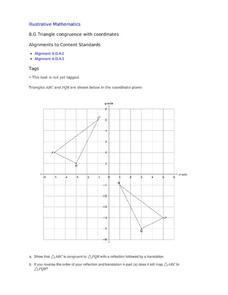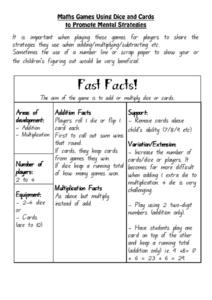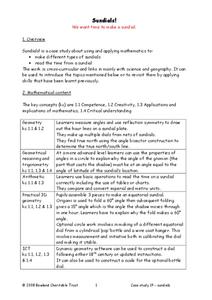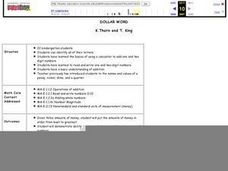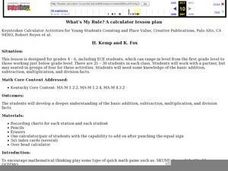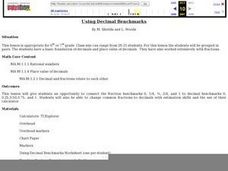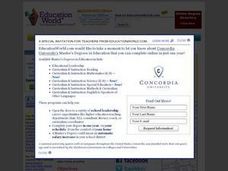Curated OER
Triangle Congruence with Coordinate
Two triangles are displayed on a coordinate plane. Youngsters apply a reflection and a translation to demonstrate their congruence. This exercise makes a terrific tool for teaching these concepts, or a way to assess learning.
Pedago Net
Math Games Using Dice and Cards to Promote Mental Strategies
Develop mental math skills using these fun partner games. Covering basic operations, each one offers differentiation options, extension ideas, and clear directions. Dice or cards is all you'll need to keep kids' attention as they...
Kenan Fellows
Isotopic Pennies
Many people confuse atomic mass and atomic numbers. The sixth of seven lessons in a unit requires scholars to find the weight of different groups of pennies. Then, they must solve how many of each type of penny exists in a closed system...
EngageNY
Proving Trigonometric Identities
Young mathematicians first learn the basics of proving trigonometric identities. They then practice this skill on several examples.
Bowland
Sundials!
Time to learn about sundials. Scholars see how to build sundials after learning about Earth's rotation and its relation to time. The unit describes several different types of possible sundials, so choose the one that fits your needs — or...
NOAA
How Do We Know?: Make Additional Weather Sensors; Set Up a Home Weather Station
Viewers learn about three different weather measurement tools in installment five of the 10-part Discover Your Changing World series. They build weather vanes to collect data on wind speed, barometers to determine air pressure, and...
Curated OER
Independent Practice: 3 and 4 Digit into 4 Digit Division
In this long division worksheet, learners solve 20 different problems related to dividing with 3 and 4 digits. They divide each 3 and four digit number into a four digit number to get the correct answer for each problem.
Space Awareness
Where on Earth Am I?
Almost every phone has GPS installed, but a large number of teens don't know how the technology works. An initial activity illustrates how GPS determines a location on Earth. Scholars then apply trilateration procedures to a...
Curated OER
Divisor The Great! (Divide by Two-Digit Divisors)
Manipulatives make learning division easier! Your class will discover the difference between dividing with one- and two-digit divisors, and practice the procedures for each using the standard algorithm. They will use estimation to ensure...
Elementary AMC
Earth Day Math
Take some time this Earth Day to nourish the growth of your young mathematicians with this series of task cards. Whether it's the four basic operations, place value, money, or elapsed time, these conservation-themed problems...
Curated OER
Dollar Word
Students review the value of coins prior to adding up values to equal one dollar. Letters of the alphabet are assigned monetary values and students use calculators to add up the value of a word. Students work with a partner to try and...
Curated OER
Subtraction With Integers
This thorough introduction to the concept of subtracting negative integers walk learners through the necessary steps using teacher modeling and guided practice. Number lines and various word problems are used to support understanding of...
Curated OER
Fractions: Jim and John
Elementary and secondary learners investigate various concepts related to the study of fractions. They use word problems during the introduction to parts of a fraction and proceed to some of the basic operations of using fractions. The...
Curated OER
Number Sense and Operations
In this math story problem worksheet, students read the 9 story problems and select the correct answer from the 4 choices available. The top of this worksheet indicates that it is appropriate for Grade 5.
Curated OER
Using Algebra to Solve Puzzles
Students explore basic algebraic operations to solve real life situations. Additional problems are presented to continue the exploration of the concept.
Curated OER
Adding Ten Tiles I
Students practice this problem that needs a certain amount of experimentation (trial and error) to get any answer at all. In the process they practice their basic number facts. However, to get the complete set of answers Students need to...
Curated OER
Euclidean Algorithm
Students are introduced to the concept of a Greatest Common Divisor. They review the number systems. Students are told how the entire field of Number Theory primarily uses the integers. They are told the Fundamental Theorem of Algebra.
Curated OER
Calculators
Students investigate the four basic operations of mathematics that are addition, subtraction, multiplication, and division. The use of a technology game is part of the lesson. They demonstrate the proper use of a calculator as part of...
Curated OER
"How Many Names for 100?"
Fifth graders work on the different possibilities of reaching the number 100. The class is divided into homogeneous groups for cooperative learning. The lesson uses discussion questions to help with problem solving.
Curated OER
Using Decimal Benchmarks
Students demonstrate some common operations done while using fractions based upon mathematical standards. They are also changing common fractions to decimals with estimation skills and the use of a calculator.
Curated OER
Online Math Facts Games
Pupils use online games to reinforce math-facts knowledge, engage in a game the way they might be engaged in an arcade game, and try to be one of the class's top-scorers each week. A good filler or extension activity.
Curated OER
Math: Greater Than, Less Than, Equals
Elementary schoolers learn about using the symbols for greater than, less than and equal to. They answer nine questions using the information they learned. The answers are on the last page of the packet.
Curated OER
Family at Home
Students fold paper to form a house, then use three numbers to make fact families for their houses. They write a family of multiplication and division facts on a piece of paper cut in the shape of a house.
Curated OER
Introduction to Graphs
Students poll classmates to gather information for a graph. They identify three types of graphs (bar, line, table). Students create each type of graph using data gathered from classmates.


